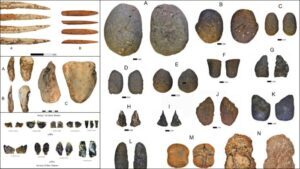
Ateneo de Manila University—In 15 years of groundbreaking archaeological research, scientists from the Ateneo de Manila University, working with international experts and institutions, have established compelling evidence of the pivotal role of the Philippine archipelago in ancient maritime Southeast Asia. They uncovered a story of effective human migration, advanced technological innovation, and long-distance intercultural relations dating back over 35,000 years.
The Ateneo researchers’ latest publication presents a wealth of data and materials from the Mindoro Archaeology Project, including some of the oldest evidence of the presence of anatomically modern humans (Homo sapiens) in the Philippine archipelago, in Occidental Mindoro—particularly on Ilin Island; San Jose; and Sta. Teresa, Magsaysay.
Mindoro, like most of the main Philippine islands except for Palawan, was never connected to mainland Southeast Asia, neither by land bridges nor by ice sheets, and sea-crossings were always necessary to reach it. This likely spurred the development of sophisticated technologies for traversing and surviving this environment.
Evidence of sophisticated ancient technology on Philippine islands
A variety of finds such as human remains, animal bones, shells, and tools made from stone, bone and shell show that Mindoro’s early inhabitants successfully harnessed both terrestrial and marine resources such that, over 30,000 years ago, they already possessed seafaring capabilities and specific fishing skills that enabled them to catch predatory open-sea fish species, such as bonito and shark, and to establish connections with distant islands and populations in the vast maritime region of Wallacea.
Particularly noteworthy is the innovative use of shells as raw material for tools since more than 30,000 years ago. This culminated in the manufacture of adzes from giant clam shells (Tridacna species), dating back 7,000-9,000 years ago. These bear a striking similarity to shell adzes found across the region of Island Southeast Asia and as far as Manus Island in Papua New Guinea, over 3,000 kilometers away.
The researchers also found on Ilin Island a human grave dating to around 5,000 years ago, with the body laid to rest in a fetal position and bedded and covered with limestone slabs. The manner of burial was similar to other flexed burials found across Southeast Asia, suggesting shared ideological and social influences and an emerging social complexity across a vast area from the mainland to distant islands.
Mindoro hints at vast, advanced maritime network
Mindoro’s archaeological sites have yielded evidence of culturally sophisticated inhabitants who were behaviorally and technologically adapted to coastal and marine environments. Collectively, these discoveries suggest that Mindoro and nearby Philippine islands were part of an extensive maritime network that existed already during the Stone Age and facilitated cultural and technological exchange between early human populations across Island Southeast Asia for many millennia.
By documenting human habitation over a long period of time, with the emergence of advanced subsistence strategies and maritime technologies, the Mindoro Archaeology Project not only fills critical gaps in the prehistoric record of the Philippines but also redefines the region’s significance in the broader narrative of human migration and adaptation in Island Southeast Asia.
The latest publication* of the Mindoro Archeology Project is authored by the Ateneo de Manila University Department of Sociology and Anthropology’s Dr. Alfred F. Pawlik, Dr. Riczar B. Fuentes, and Dr. Tanya Uldin; together with Dr. Marie Grace Pamela G. Faylona of the University of the Philippines – Diliman Department of Anthropology, De La Salle University Department of Sociology and Behavioral Sciences, and Philippine Normal University College of Advanced Studies; and Trishia Gayle R. Palconit, PhD student at the University of Ferrara, Italy.
__________________________

A map of Island Southeast Asia (ISEA) and the Sunda region as it appeared roughly 25,000 years ago at the height of the last Ice Age, with locations of archaeological sites surveyed by the Mindoro Archaeology Project. The sites yielded artifacts with remarkably similar characteristics despite separation by thousands of kilometers and deep waters that are almost impossible to cross without sufficiently advanced seafaring knowledge and technology. The Mindoro Archaeology Project (Base Map: www.gebco.net, 2014)
__________________________

Samples of ancient technology discovered in and around Mindoro. Clockwise, from upper left: a bone fishing gorge (A) and a possible gorge fragment (B); hammer stones (A-F), pebble tools (G-L), and net sinkers (M, N); obsidian cutting tools from Mindoro (top) and Palawan (bottom), exhibiting similar chemical composition; and Tridacna giant clam shell adzes (A,B) and a shell tool (C). Photos and figures by A. Pawlik; after Pawlik et al. 2025; Pawlik & Piper 2019; Neri et al., 2015
__________________________
Article Source: Ateneo de Manila University news release.
*Philippine islands had technologically advanced maritime culture 35,000 years, Archaeological Research in Asia, 10.1016/j.ara.2025.100616




